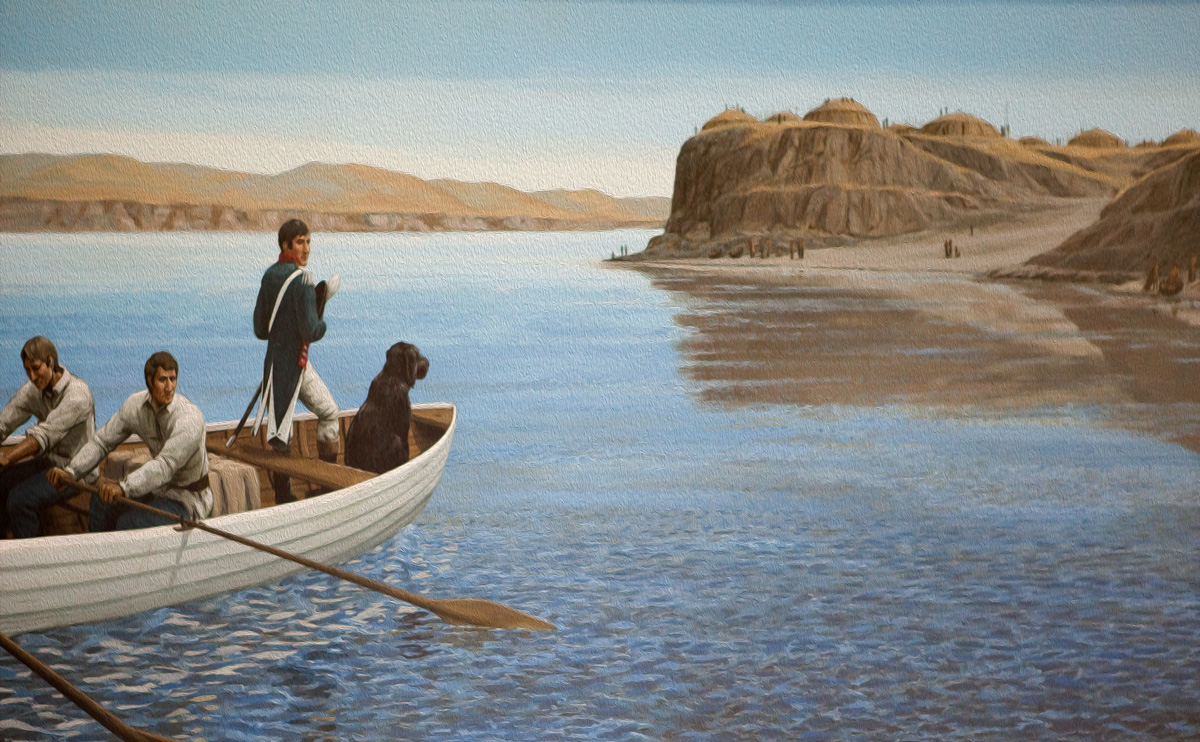Trader Hugh McCracken leaves with a letter and a copy of Lewis’s British passport bound for the North West Company’s Fort Assiniboine. Sheheke and two other Mandan chiefs come to camp and say they are willing to make peace with the Arikaras. In the evening, Clark drops nine miles below the Knife River Villages to establish winter quarters and Lewis visits Mitutanka to get corn.
Looking for a Winter Campsite
by Yellowstone Public Radio[1]Originally aired weekdays by Yellowstone Public Radio during the Bicentennial observance of 2003-2006. Narrated by Hal Hansen. Scripts by Whit Hansen and Ed Jacobson. Produced by Leni Holliman. © … Continue reading
Lewis and Seaman Visit a Mandan Village
Painting created by Split Rock Studios, Sioux City, Iowa. Original in the collection of the Lewis and Clark Trail Heritage Foundation and photographed by Kristopher K. Townsend.
Captain Lewis stands and his dog Seaman sits while two soldiers row the white pirogue to a Mandan village.
McCracken Leaves
Mr. McCrackin a Trader Set out at 7 oClock to the fort on the Ossiniboin by him Send a letter, (incloseing a Copy of the British Ministers protection) to the principal agent of the Company—
—William Clark
Mandan Chiefs Visit
at about 10 OClock the Cheifs of the Lower Village Cam and after a Short time informed us . . . that they would make peace with the Ricares [Arikaras] they never made war against them but after the rees Killed their Chiefs they killed them like the birds, and were tired and would Send a Chief and Some brave men to the Ricares to Smoke with that people in the evening
—William Clark
Looking for Winter Quarters
At 3 o’clock P. M. we returned down the river, to look for a place where we could fix our winter quarters. At dark we had descended 9 miles, and came to a bottom covered with cotton wood, where we encamped.
—Patrick Gass
Visiting Mitutanka
Capt. Lewis myself and Several more of the party halted at the 1st village of the Mandens [Mandans] in order to git Some corn. the head chief told us that they had not Got the corn ready. But if we would come tomorrow they [w]ould have it ready. they Gave us 3 kinds of victuls to eat which was verry Good. they were verry friendly Gave the pipe round everry fiew minutes &.C. they live verry well. have pleanty of corn Beans Squashes meat &.C.
—John Ordway
Weather Diary
Ther. at rise
Weather Wind at rise
Thert. at 4 P.M. Weather Wind at 4 P.M. 31 fair N. W. 47 fair N. W. the winds blue so heard this day that we could not decend the river untill after 5 P.M. when we left our
—Meriwether Lewis[2]To assist the reader, the editor of this web page has omitted the “day of the month” and “River Feet” columns and spelled out some abbreviations.
Knife River Indian Villages National Historic Site is a High Potential Historic Site along the Lewis and Clark National Historic Trail managed by the U.S. National Park Service. A unit of the National Park System, the site is located at 564 County Road 37, one-half mile north of Stanton, North Dakota. It has exhibits, trails, and a visitor center.
Notes
| ↑1 | Originally aired weekdays by Yellowstone Public Radio during the Bicentennial observance of 2003-2006. Narrated by Hal Hansen. Scripts by Whit Hansen and Ed Jacobson. Produced by Leni Holliman. © 2003 by Yellowstone Public Radio. |
|---|---|
| ↑2 | To assist the reader, the editor of this web page has omitted the “day of the month” and “River Feet” columns and spelled out some abbreviations. |
Experience the Lewis and Clark Trail
The Lewis and Clark Trail Experience—our sister site at lewisandclark.travel—connects the world to people and places on the Lewis and Clark Trail.
Discover More
- The Lewis and Clark Expedition: Day by Day by Gary E. Moulton (University of Nebraska Press, 2018). The story in prose, 14 May 1804–23 September 1806.
- The Lewis and Clark Journals: An American Epic of Discovery (abridged) by Gary E. Moulton (University of Nebraska Press, 2003). Selected journal excerpts, 14 May 1804–23 September 1806.
- The Lewis and Clark Journals. by Gary E. Moulton (University of Nebraska Press, 1983–2001). The complete story in 13 volumes.




